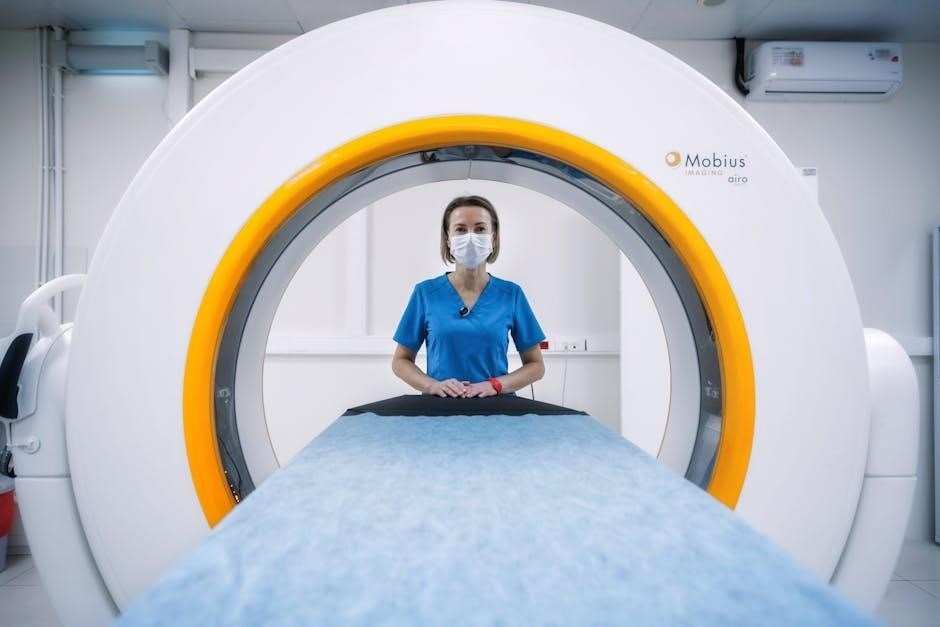The Schmitt-Thompson Protocols are evidence-based clinical guidelines designed to support healthcare professionals in telephone triage and telehealth services, ensuring efficient and safe patient care decisions․
1․1 Overview of the Schmitt-Thompson Clinical Content
The Schmitt-Thompson Clinical Content provides evidence-based telephone triage guidelines for both pediatric and adult patients․ These protocols are annually reviewed and updated, offering decision-support tools for nurses and telehealth providers․ They cover a wide range of clinical conditions, ensuring safe and effective patient care recommendations․ The content is structured to guide data collection, assessment, and disposition, making it a trusted resource in healthcare settings․
1․2 Importance of the Protocols in Healthcare Triage
The Schmitt-Thompson Protocols are vital in healthcare triage, offering standardized, evidence-based decision-support tools․ They enhance patient safety by providing clear guidance for nurses and telehealth providers, ensuring appropriate care recommendations․ These protocols improve efficiency in triage processes and support high-quality healthcare advice, making them indispensable in both telehealth and traditional clinical settings for effective patient management and resource allocation․

History and Development of the Protocols
The Schmitt-Thompson Protocols were created over 20 years ago by Dr․ Barton Schmitt and Dr․ David Thompson, evolving from pediatric guidelines to include adult care, with annual updates ensuring relevance and accuracy in clinical practice․
2․1 Creation and Evolution of the Schmitt and Thompson Guidelines
The Schmitt and Thompson Guidelines originated from Dr․ Barton Schmitt’s work in pediatric care, expanding to include adult protocols developed by Dr․ David Thompson․ Initially focused on telephone triage, they have evolved to support telehealth services, with annual updates incorporating new clinical evidence and feedback from healthcare providers, ensuring they remain a trusted resource for decision-making in patient care․
2․2 Key Contributors: Dr; Barton Schmitt and Dr․ David Thompson
Dr․ Barton Schmitt, a pediatrician, and Dr․ David Thompson, an adult care specialist, pioneered the Schmitt-Thompson Guidelines․ Their collaborative effort established standardized triage protocols, blending pediatric and adult care expertise․ Schmitt focused on pediatric telephone triage, while Thompson expanded the scope to adult care, ensuring comprehensive coverage․ Their work laid the foundation for evidence-based decision-support tools widely used in healthcare systems today․

Clinical Applications of the Protocols
The Schmitt-Thompson Protocols are widely applied in telephone triage and telehealth services, assisting healthcare providers in making informed decisions for both pediatric and adult patient care․
3․1 Use in Telephone Triage and Telehealth Services
The Schmitt-Thompson Protocols are primarily used in telephone triage and telehealth services, providing decision-support tools for healthcare providers to assess symptoms, guide data collection, and determine appropriate dispositions․ They enhance safety and access to testing programs, ensuring high-quality healthcare advice․ Annual updates incorporate new clinical evidence, maintaining relevance and effectiveness in remote patient care settings․
3․2 Application in Pediatric and Adult Care Settings
The Schmitt-Thompson Protocols cater to both pediatric and adult populations, offering specialized guidelines for each․ The Schmitt protocols focus on pediatric care, while Thompson addresses adult needs, ensuring age-appropriate triage decisions․ These evidence-based tools help nurses assess symptoms, determine dispositions, and provide safe, effective care tailored to the unique requirements of each patient group, enhancing outcomes across all age ranges․
Structure and Components of the Protocols
The Schmitt-Thompson Protocols include structured data collection processes, triage algorithms, and decision-support tools to guide nurses and healthcare providers in assessing symptoms and determining appropriate care․
4․1 Data Collection and Triage Process
The Schmitt-Thompson Protocols facilitate systematic data collection through structured questioning, focusing on symptoms, medical history, and severity․ This process enables triage nurses to categorize patients by urgency, ensuring appropriate care recommendations and resource allocation․ The protocols incorporate evidence-based guidelines, triage algorithms, and decision-support tools to enhance accuracy and consistency in patient assessments, ultimately improving outcomes and operational efficiency in healthcare settings;
4․2 Disposition and Decision-Support Tools
The Schmitt-Thompson Protocols include disposition guidelines that direct appropriate care levels, from self-care to emergency intervention․ Decision-support tools, such as algorithms and evidence-based recommendations, assist healthcare providers in making informed decisions․ These tools enhance clinical accuracy, reduce errors, and ensure standardized care․ They also facilitate efficient patient prioritization, improving resource allocation and overall healthcare delivery in both telehealth and in-person settings․
Adoption and Implementation in Healthcare Systems
Healthcare systems integrate Schmitt-Thompson protocols into call centers and software, enhancing triage efficiency and standardizing care delivery across diverse patient populations․
5․1 Integration into Call Center Solutions
Schmitt-Thompson protocols are seamlessly integrated into call center software, providing triage nurses with decision-support tools․ Annual updates, including red-line documents, ensure adherence to the latest clinical guidelines․ This integration enhances efficiency, consistency, and accuracy in patient care delivery across call centers, supporting healthcare systems in maintaining high standards of triage and patient safety․
5․2 Software Solutions for Triage Nurses
Software solutions incorporating Schmitt-Thompson protocols offer triage nurses structured decision-support tools․ These platforms streamline data collection, triage, and disposition processes, ensuring adherence to evidence-based guidelines․ Features include real-time updates, customizable checklists, and integration with electronic health records, enabling nurses to provide high-quality, efficient care while maintaining patient safety and compliance with clinical standards․
Update Process and Maintenance of the Protocols
The Schmitt-Thompson protocols undergo annual reviews, with updates reflected in red-line documents․ This ensures the guidelines remain current, incorporating new clinical evidence for optimal patient care․
6․1 Annual Reviews and Red-Line Documents
The Schmitt-Thompson protocols are reviewed annually to ensure they reflect the latest clinical evidence․ Red-line documents highlight changes, making it easier for users to track updates and implement them effectively in their practice․ This process ensures the guidelines remain relevant and evidence-based, supporting healthcare providers in delivering high-quality care․
6․2 Incorporation of New Clinical Evidence
New clinical evidence is systematically integrated into the Schmitt-Thompson protocols through a rigorous review process․ This ensures that the guidelines remain current and align with the latest research and best practices in healthcare․ By incorporating fresh evidence, the protocols maintain their effectiveness in supporting accurate triage decisions and improving patient outcomes across various clinical settings․

Pediatric vs․ Adult Guidelines
Schmitt-Thompson protocols offer distinct guidelines for pediatric and adult care, addressing age-specific conditions and developmental needs․ Pediatric guidelines focus on childhood illnesses and growth-related issues, while adult protocols emphasize chronic disease management and specific treatment options, ensuring tailored care for diverse patient populations․
7․1 Differences in Approach and Application
The Schmitt-Thompson protocols distinguish between pediatric and adult care through tailored approaches․ Pediatric guidelines emphasize childhood illnesses, developmental milestones, and growth-related concerns, often incorporating visual aids for better understanding․ Adult protocols focus on chronic disease management, comorbidities, and specific treatment options․ Both sets of guidelines ensure accurate triage and decision-making, adapting to the unique needs of each population for optimal patient outcomes․
7․2 Specific Tools for Telehealth Care Providers
The Schmitt-Thompson protocols provide specific tools for telehealth care providers, including detailed decision-support algorithms and evidence-based guidelines․ These tools enhance remote patient assessments, ensuring accurate triage and appropriate care recommendations․ They also offer structured documentation templates and integration with telehealth platforms, enabling efficient and high-quality healthcare advice tailored to both pediatric and adult populations․
Role in Telehealth and Remote Patient Care
The Schmitt-Thompson protocols play a crucial role in telehealth by enabling safe and efficient remote patient assessments, enhancing access to testing programs, and providing decision-support tools for healthcare providers․
8․1 Enhancing Safety and Access to Testing Programs
The Schmitt-Thompson protocols enhance safety by providing evidence-based guidelines for remote patient assessments, ensuring accurate triage decisions․ They improve access to testing programs, such as home COVID-19 kits, by offering clear, efficient pathways for healthcare providers to recommend testing, thereby reducing barriers to diagnosis and treatment while maintaining high standards of care;
8․2 Support for High-Quality Healthcare Advice
The Schmitt-Thompson Protocols provide standardized, evidence-based decision-support tools for nurses and telehealth providers, ensuring high-quality healthcare advice․ By incorporating clinical expertise and updated guidelines, these protocols enable consistent and reliable patient evaluations, fostering safe and effective care delivery while maintaining patient safety and improving health outcomes through accurate and timely advice․
Benefits and Limitations of the Protocols
The Schmitt-Thompson Protocols offer streamlined decision-making, improving triage efficiency, and ensuring patient safety․ However, their effectiveness depends on proper implementation and user adherence to guidelines, with updates needed to address evolving clinical practices and patient needs․
9․1 Advantages in Decision Support and Efficiency
The Schmitt-Thompson Protocols provide clear, evidence-based decision support, enhancing clinical efficiency and reducing errors․ They standardize care processes, ensuring consistent patient outcomes and improving triage accuracy․ By streamlining data collection and disposition, these tools enable healthcare providers to deliver timely, high-quality advice, making them indispensable in telehealth and call center environments․
9․2 Potential Challenges and Feedback Mechanisms
Despite their effectiveness, challenges include the need for continuous updates to reflect medical advancements and potential integration difficulties in diverse healthcare settings․ Feedback mechanisms, such as annual reviews and clinician input, help identify areas for improvement, ensuring the protocols remain relevant and practical for evolving patient care needs and technological advancements․

Future Directions and Innovations
Future directions involve expanding into new clinical areas and integrating with emerging technologies, ensuring the protocols adapt to modern healthcare demands and innovations․
10․1 Expansion into New Clinical Areas
The Schmitt-Thompson protocols aim to expand into emerging clinical areas, including chronic disease management, mental health, and geriatric care, ensuring comprehensive coverage of diverse patient needs while maintaining their evidence-based foundation and adaptability to evolving healthcare challenges and technological advancements․
10․2 Integration with Emerging Healthcare Technologies
The Schmitt-Thompson Protocols are increasingly integrated with emerging technologies such as telehealth platforms and AI-driven tools, enhancing their accessibility and efficiency․ This integration supports seamless data collection and decision-making, aligning with advancements in digital health․ By incorporating new technologies, the protocols continue to provide reliable, evidence-based guidance, ensuring they remain a cornerstone of modern healthcare delivery and triage systems․
